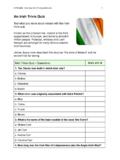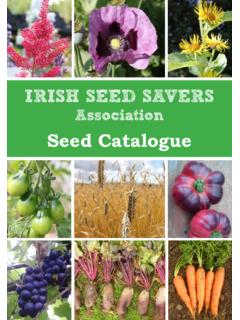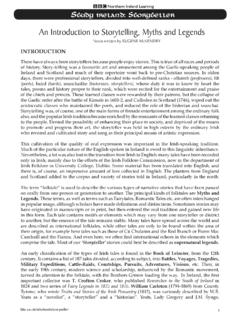Transcription of SEAWEED INDUSTRY IN EUROPE
1 SEAWEED INDUSTRY IN In the past, storm cast* SEAWEED was gathered on foot and without mechanization or any equipment. Since the beginning of the 17th century, the commercial use of SEAWEED , for commercial purposes, such as in the production of glass, encouraged local populations to regulate the activity by establishing rules. For example in France, the first national text, regulating SEAWEED harvesting, is an ordinance of 1681 which fixed the harvesting seasons of kelp and the number of authorized harvesting days. The use of SEAWEED for iodine production and later for alginate prompted improvements in harvesting techniques, in order to meet the increasing industrial demand INDUSTRY for the raw material. Equipment to cut SEAWEED and boats to carry the algae ashore were first used early in the twentieth century.
2 In 1970, harvesting of Laminaria digitata and Laminaria hyperborea was mechanized in France and Norway. In EUROPE , the main exploited algae species are Laminaria hyperborea, Laminaria digitata and Ascophyllum nodosum. These species, and especially kelp forests, are considered among the most ecologically dynamic and biologically diverse habitats on the planet. Other species are found on the European Atlantic coast but few of them currently have a commercial value. European scientists have mainly focused their research mainly on kelp which is considered a Keystone Species and whose presence affects the survival and abundance of many other species in the ecosystem. Nowadays, the preservation of kelp forests is placed at the center of environmental concerns and some countries have decided to protect these habitats by restricting the use of mechanical harvesting or by creating protected areas around them.
3 Within this context, mechanical kelp harvesting and SEAWEED gathering by foot, generate much discussion between scientists, fishers, processing industries and environmental non-gouvernemental organisations. Kelp harvesting is blamed for harming the ecosystem because of the damage it can cause to substrates and to the habitats of certain fish. For some scientists the removal of the kelp species provokes negative effects on the invertebrate species that live in the holdfast, the stipe or fronds or under the fronds. In countries where Laminaria spp is harvested with mechanical equipment, scientists appear to be concerned with the equipment s impact on the species and also on the surrounding ecosystem. This document presents the main characteristics of the SEAWEED INDUSTRY in EUROPE , illustrated by examples from six European countries (Norway, France, Ireland, Spain, United Kingdom and Portugal).
4 The aim is to have an overview of the European SEAWEED INDUSTRY from the six baseline reports prepared by the partners of this project, from literature sources and information gathered during semi-structured interviews of different stakeholders. This document briefly presents the history of SEAWEED harvesting activity in EUROPE , the current production and the techniques used in the different countries. The different regulatory systems for the resource and coastal access are detailed followed by the management of the resource and finally the management of the human beings focusing on the social dimension of the activity. The diverse uses of the SEAWEED resource are outlined. *material deposited on the shore after HARVESTING: AN ANCIENT ACTIVITYOn the European Atlantic coast, macroalgae have been harvested by coastal populations for a long time.
5 Two main uses were identified: human consumption and agriculture (cattle food and soil enrichment). Archaeologists and ethnologists have mentioned other uses such as fuel, mattresses, etc. The first recorded commercial use of SEAWEED is in the 17th century when it was used for the production of glass (France, Norway). Coastal populations, mainly farmers, gathered and burnt algae to produce ash, a source of potash for the production of glass and soap. The development of these industries has strongly changed the functioning of coastal populations. Several historical sources from Norway refer to conflicts between farmers and navigators regarding the dense smoke from algae burning. In, 1800, Norway exported 1500 tons of potash for the production of glass and soap. On the French Atlantic coast, the farmers also gathered SEAWEED and dried them on the dunes.
6 The use of kelp, for potash production, became so intensive that it altered the structure of the harvesting. This activity was so labour intensive to meet the INDUSTRY s demand and that it required the participation of the whole family. In addition, the coastal communities often called the inland communities for , SEAWEED harvesting also considerably increased in Ireland. As the population increased and as the land was divided among children of a same family, pressure on the productivity of the land lead small holders to use SEAWEED as fertilizers to produce quantities of subsistence crops beyond the normal capabilities of their the 19th century, the use of SEAWEED shift from for the potash production for the glass INDUSTRY to the production of iodine. The iodine production constituted the main use of SEAWEED until the 2nd World War when chemical material replaced SEAWEED .
7 The European SEAWEED INDUSTRY however persisted thanks to the discovery of hydrocolloids and especially alginic acid. Even the first extraction of alginates began early in some countries, it was only at the end of 1950 s that industrial production became oven used to burn kelp, Balanec Vincent Squiban, Kelp harvesting on Mol ne Island (Brittany, France), 1953, Revue Semaine du Monde, 4 The European SEAWEED INDUSTRY is mainly based on the harvesting of macroalgae. Consistent data about SEAWEED production are difficult to find and also subject to caution as it is rarely made clear if the data refer to raw material or to dried material. FAO statistics are the only source of data covering all countries in the world. According to these data, over 15 million tons of macroalgae (brown, red and green) were produced worldwide from capture and aquaculture in 2009.
8 The world production increases by every year. Capture production accounts for only a few percent of the total. Cultivated SEAWEED is produced mainly in Asia. In EUROPE the production remained stable above 350,000 tons until 2000 and has since decreased by almost one third. The reversal of this trend will depend on stable access to raw material, the development of value added products and the transfer of expertise between regions where the production is well developed and those wishing to promote the INDUSTRY . In the six countries studied several hundred of species are found but only few dozen all of them are commercial value and the amount of landing for each species vary and are directly linked to harvesting techniques. The most important, in terms of landings and value, are Laminaria digitata, Laminaria hyperborea and Ascophyllum nodosum.
9 This importance is explained by the fact that Laminaria digitata and Laminaria hyperborea are both harvested mechanically by boat in France and Norway. Ascophyllum nodosum, is harvested by boat in Norway. In France and Ireland, Ascophyllum nodosum is harvested manually. All the other species are harvested manually either on foot or by diving. SEAWEED PRODUCTION AND SPECIES IN EUROPES peciesGathered by hand on shore (drift and attached)Mechanical harvestingDivingFarming (including trials)Alaria esculenta Ascophyllum nodosum Asparagopsis armata Chondrus crispus Codium sp. Corallina officinalis Dilsea carnosa Fucus ssp Gelidium corneum Gelidium sesquipedale Gigartina pistillata Gracilaria spp. Himanthalia elongata Laminaria digitata Laminaria hyperborea Mastocarpus stellatus Palmaria palmata Porphyra umbilicalis Saccharina latissima Ulva sp.
10 Undaria pinnatifida Species harvested and harvesting techniques in EUROPE 5 Mechanical harvesting is undertaken by boats and is mainly practiced in Norway (Rogaland to S r-Tr ndelag), France (Brittany), Spain (Galicia and Asturias) and to a lesser degree in the Basque country (France) and Ireland. The development of the mechanization of SEAWEED harvesting occurred in the middle of 1970 s in France and Norway in response to the increasing demand for raw material for the alginate extracting INDUSTRY . The evolution and success of mechanization was due to the close collaboration between scientists and fishers, and to exchanges between these two countries. In Norway, Laminaria hyperborea and Ascophyllum nodosum are harvested by boats using respectively a SEAWEED trawl(1), a paddle wheel cutter(3) or a vaccum-sucker(4).







